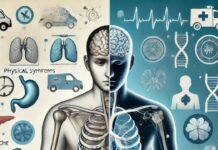A stroke can be life-changing not only for the person who suffers from it but also for their entire family. This tragic occurrence has the potential to cause premature death and impairment for the rest of one’s life. In India, the stroke incidence rate is predicted to be 119 to 145 per 100,000 persons, with 1.44 to 1.64 million stroke cases per year. When we ignore the warning signals of a stroke, we can become victims of this life-threatening event.
TIA cause
The Transient Ischaemic Attack (TIA) or mini-stroke is one such symptom. The risk of stroke in the first three months after a TIA has been estimated to be 2-17 percent. Without treatment, about 33% of those who have had a TIA will suffer a major stroke within a year.
When the blood supply to the brain is interrupted for a brief period of time (less than 5 minutes), it generates a transitory neurological symptom similar to a stroke, although it is quickly reversible. This is referred to as TIA.
Because it is a tiny form of a full-blown stroke, TIA is also known as a mini-stroke. It causes less damage, but it still necessitates immediate medical attention.
Difference from stroke
When a blood clot blocks an artery that supplies blood to the brain, oxygen deprivation occurs, resulting in TIA. A transient bottleneck is frequently moved along and broken down in a TIA. As a result, the normal blood flow to the brain resumes fast. A TIA’s symptoms usually go away after an hour (usually less than 15 minutes), although they can continue up to 24 hours in some situations. An ischemic stroke, on the other hand, causes the brain to be oxygen-depleted for a prolonged period of time. This causes greater harm and has long-term consequences that can be lethal, resulting in permanent disability or death.
Aside from issues we can’t control, such as age and family history, women are more likely than men to have a stroke or TIA.
Obesity, carotid artery disease, high blood pressure, high cholesterol, diabetes, and pre-existing cardiac diseases have all been linked to an increased risk of stroke/TIA. Excessive smoking, alcohol consumption, high-cholesterol diets, and the use of drugs like amphetamines, cocaine, and heroin can all raise the risk.
Symptoms and warning indicators
We must make an effort to recall the term “FAST” (which denotes Face, Arms, Speech, Time). These are most commonly noticed in people who are having a TIA.
These include:
Where the eyes or mouth droop to one side, this is known as facial droop. It’s also possible that you’ll have difficulty smiling. Speech problems, such as slurred, garbled, or difficult to comprehend speech. It may also be challenging to come up with the proper words.
Weakness or numbness of the limbs may occur. It’s possible that lifting or holding up the arms will be difficult.
Balance and coordination issues, blindness or brief blurring of vision, inability to move one side of the body, dizziness, disorientation and difficulty comprehending others are all possible symptoms.
Changes in your way of life
After learning about TIA, it’s critical to work toward a healthier lifestyle and take preventative actions to lower the risk of having a TIA/stroke.
These include:
- Quitting smoking and avoiding tobacco-related secondhand smoke.
Eating a well-balanced, nutritious diet rich in fresh fruits and vegetables. - Keeping an eye on excessive salt and fat consumption
Regular exercise is essential. - Avoiding the use of recreational drugs.
- Keeping a healthy body weight. For heart disease, diabetes, and other health issues, follow the recommended/timely treatment plan.
Management and Diagnosis
A complete physical examination, neurological tests, and several imaging modalities are used to make a diagnosis (MRI, Angiography, etc).
Depending on the severity of the TIA, blood thinners and anti-cholesterol drugs may be prescribed, along with or without the use of minimally invasive techniques (carotid angioplasty/stenting) and surgical procedures (Carotid endarterectomy).
Even if the symptoms of a TIA stroke fade, medical care should be sought quickly. It’s important to keep in mind that there’s a lot of ambiguity about whether or not the blood flow will return on its own. Because the symptoms are so similar, it’s impossible to tell if someone is having a TIA or a stroke. Furthermore, under the current pandemic circumstances, the Covid-19 has the potential to cause blood clots in the brain’s blood vessels. This can lead to a transient ischemic attack (TIA) or a stroke.
Apart from it, you can read these articles: Samsung Galaxy S21 FE review, DaBaby net worth, Shetland Season 6, Primal Season 2, Cells at work Season 2, Goku, 6ix9ine net worth, The Shannara Chronicles Season 3, Death Note season 2, KProxy, Kung Fu Panda 4, 7StarHD, 123Mkv, Afdah, FFMovies, Bolly4U, Moviesflix, TrueID, Crystals for Protection, Mewing, How to charge crystals, Knightfall Season 3, Vampire Diaries season 9, Homeland Season 9, Sherlock season 5, Goodyear Viva 3, High sleeper bed, Cash for Cars, F95zone, the 100 Season 8, Salvation Season 3, Shadowhunters season 4, Poldark season 6, Good Place season 5, Madison beer net worth, Gravity Falls season 3, Hunter x Hunter season 7, Marvelous Mrs. Maisel Season 4, Bloodborne 2, Derry Girls season 3, and Knightfall Season 3, you can follow our Entertainment, Health, Technology, and Business category.














![Technical Aspects of 844 Area Code in 2024 [Detail Guide] 844 Area Code](https://articleify.com/wp-content/uploads/2024/01/844-Area-Code-150x150.jpg)














